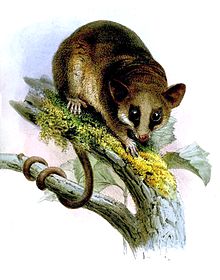- Linnaeus's mouse opossum
-
Linnaeus's Mouse Opossum[1] 
Conservation status Scientific classification Kingdom: Animalia Phylum: Chordata Class: Mammalia Infraclass: Marsupialia Order: Didelphimorphia Family: Didelphidae Genus: Marmosa Species: M. murina Binomial name Marmosa murina
(Linnaeus, 1758)
Linnaeus's Mouse Opossum range Linnaeus's Mouse Opossum (Marmosa murina), also known as the Common or Murine Mouse Opossum, is a South American marsupial of the family Didelphidae.
Contents
Range and habitat
Its range includes Colombia, Venezuela, Trinidad and Tobago, Guyana, Suriname, French Guiana, Brazil, eastern Ecuador, eastern Peru, and eastern Bolivia.
This opossum is most commonly sighted near forest streams and human habitation. A nocturnal creature, it shelters during the day in a mesh of twigs on a tree branch, a tree hole, or an old bird's nest.
Behavior
It eats insects, spiders, lizards, bird's eggs, chicks, and fruits.
Linnaeus's Mouse Opossum has a gestation period of approximately 13 days, and gives birth to 5–10 young.
Description
It is pale beige to grey on its underparts with short, smooth fur. Its face appears to have a black mask on it, its eyes are prominent, and its ears are very upright. Its tail, which females use to carry leaves, is much longer than the rest of its body.
Linnaeus's Mouse Opossum has a body length of approximately 11–14.5 centimetres (4.3–5.7 in), with a tail of approximately 13.5–21 cm (5.3–8.3 in) long. It weighs about 250 grams (8.8 oz).
References
- ^ Gardner, Alfred (16 November 2005). Wilson, Don E., and Reeder, DeeAnn M., eds. ed. Mammal Species of the World (3rd ed.). Baltimore: Johns Hopkins University Press, 2 vols. (2142 pp.). pp. 9. ISBN 978-0-8018-8221-0. OCLC 62265494. http://www.bucknell.edu/msw3/browse.asp?id=10400077.
- ^ Brito, D., Astua de Moraes, D., Lew, D., Soriano, P. & Emmons, L. (2008). Marmosa murina. In: IUCN 2008. IUCN Red List of Threatened Species. Downloaded on 28 December 2008.
Categories:- IUCN Red List least concern species
- Opossums
- Mammals of South America
- Fauna of Trinidad and Tobago
- Mammals of Guyana
- Fauna of Venezuela
- Animals described in 1758
Wikimedia Foundation. 2010.

